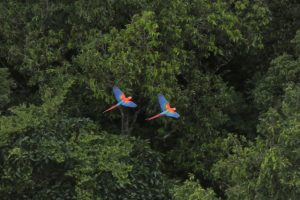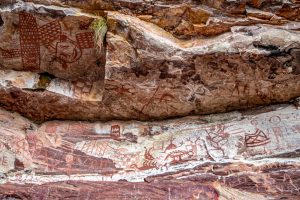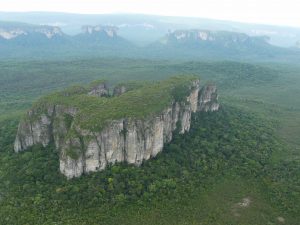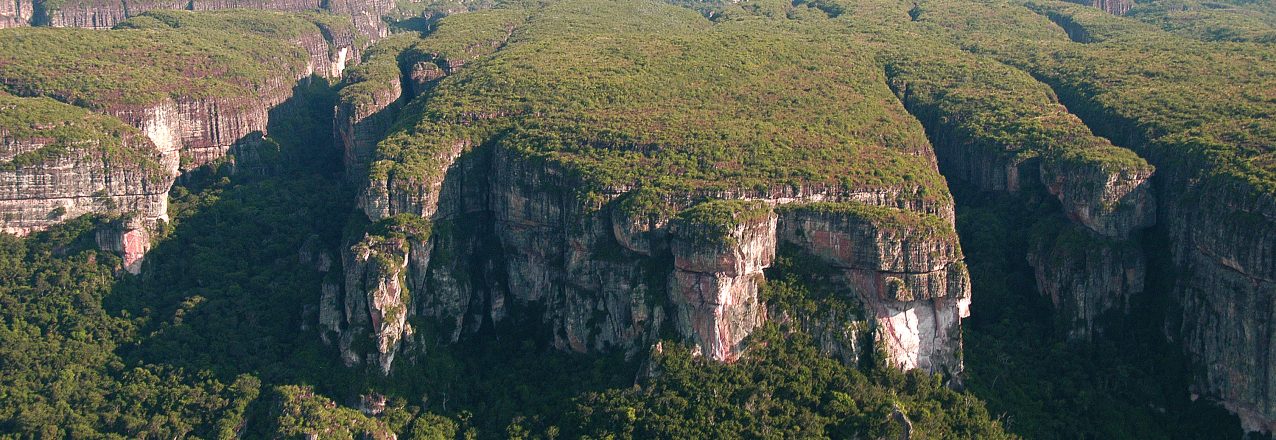USAID is partnering with the Government of Colombia to strengthen the capacity to increase sustainable land use and decrease deforestation to protect an iconic UNESCO World Heritage Site.

The Serranía del Chiribiquete was first declared a protected area in 1989 when it covered 1.3 million hectares. The government has since expanded the park to its current 4.2 million hectares, roughly the size of Denmark. As Colombia’s largest park, Chiribiquete National Park is regarded as a vital hotspot of biodiversity in the northern Amazon, sheltering jaguar, tapir, manatee, the brown woolly monkey, and giant anteater. The world’s largest protected tropical rainforest, this national park is home to hundreds of birds and butterflies species and plays a key role in global conservation.
Chiribiquete’s natural wealth goes beyond its biodiversity.

The park also bears traces of ancient human populations, perhaps the oldest inhabitants of the Americas, who lived in this territory long before the arrival of Europeans. In Chiribiquete, more than 75,000 pictograms depicting animals and humans have been discovered; some of these paintings are believed to be 20,000 years old. Today, the forest is still home to a sparse population of Indigenous Peoples, some of whom remain uncontacted and live in voluntary isolation.
This forgotten wilderness has been isolated for years due to an armed conflict that had kept tourists and Colombian settlers away from the park’s buffer zone. Getting there is not an easy endeavor, and only a small part of the park has been surveyed. In the wake of Colombia’s 2016 peace accord, biologists, botanists, and archeologists began visiting the rainforest mountain range with more frequency, and today, scientists believe the park could shelter even more biodiversity than is currently estimated.
Sadly, the buffer zones around and land inside Chiribiquete have been affected by rising rates of deforestation. In 2020, the region contained five of 12 deforestation hotspots in Colombia and was home to over 50% of the total national deforested area. In a six-month period between September 2000 and February 2021, 1,000 hectares of forest were felled and burned in the national park, according to a recent report from the Monitoring of the Andean Amazon Project.
Driving the depletion of the forest are several factors, including illicit crops, land grabbing and occupation, timber trafficking, cattle ranching inside protected areas, and the expansion of the agricultural frontier. A comprehensive solution requires the implementation of a range of policies related to security, land administration, and natural resource management.
“Chiribiquete’s large forests are critical for the water dynamics of the entire mountain range in eastern and central Colombia. Protecting the uncontacted Indigenous groups in this territory is also a challenge because of the risk of cultural loss after contact with land grabbers,” explains Carolina Jarro, Deputy Director of Management of Protected Areas at Colombia’s National Natural Parks authority.
A Land Governance Approach to Conservation
USAID is actively supporting the government’s efforts to halt deforestation in this region by improving land and environment governance tools and supporting government entities involved in land, conservation, and security. In fact, USAID has strategically aligned its environment and rural economic development/land portfolios in order to address deforestation and approach the issues of illicit crops being cultivated in hard-to-reach environmentally protected areas.

In places where the mechanism to reduce the presence of illicit crops are limited, USAID is demonstrating that land formalization can be a mechanism to strengthen conservation and natural resource management. The work includes working with mayors and municipal governments in buffer zones around the Chiribiquete National Park to strengthen land governance capacities and promote licit livelihoods for communities.
First step in protecting the forest and everything within it is delimiting the national park and adding it to the national cadaster. After this, USAID is helping the government pilot a land-use contracting program for ranchers and farmers living in the buffer zone. Finally, USAID is facilitating public-private partnerships to mobilize government and private sector investments that foster licit economic opportunities.
“Updating the cadaster is critical for territorial planning and fiscal strengthening of the municipalities, but it is also key for preventing deforestation and the destruction of environmental assets. With an updated cadaster, the park’s boundary and the characteristics of the surrounding areas can be established.” – Alejandra Botero, Presidential Counsellor for Management and Compliance.
This integrated approach has the potential to consolidate policies that can help to curb the region’s unchecked deforestation and unsustainable use of land. By updating the nation’s rural cadaster for areas around Chiribiquete and issuing legal land deeds, communities will be dissuaded from growing illicit crops and increase buy-in for a community-approach to forest management and inclusive growth around the enormous and emblematic park.
“The Government of Colombia, with the support of international cooperation, has conducted periodic flights to identify the deforestation and illegal occupation areas. These are public parcels that need to be identified to control and restore the area while reducing the possibility of affecting the natural and cultural heritage,” added Mrs. Jarro.
Learn more about the USAID Colombia Land for Prosperity activity here.


